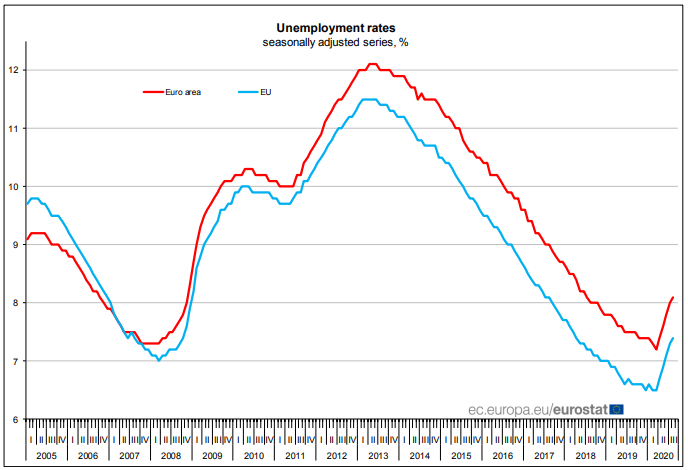Euro area unemployment at 8.1%

In August 2020, the euro area seasonally-adjusted unemployment rate has continued to rise for 5 consecutive months, reaching 8.1%. The same trend has applied to the EU unemployment rate that reached 7.4% in August 2020. These figures are published by Eurostat, the statistical office of the European Union.
Eurostat estimates that 15.603 million men and women in the EU, of whom 13.188 million in the euro area, were unemployed in August 2020. Compared with July 2020, the number of persons unemployed increased by 238 000 in the EU and by 251 000 in the euro area.

Youth unemployment
In August 2020, 3.032 million young persons (under 25) were unemployed in the EU, of whom 2.460 million were in the euro area. In August 2020, the youth unemployment rate was 17.6% in the EU and 18.1% in the euro area, up from 17.4% and 17.8% respectively in the previous month. Compared with July 2020, youth unemployment increased by 64 000 in the EU and by 69 000 in the euro area.
Unemployment by gender
In August 2020, the unemployment rate for women was 7.6% in the EU, up from 7.5% in July 2020. The unemployment rate for men was 7.1% in August 2020, stable compared with July 2020. In the euro area, the unemployment rate for women increased from 8.3% in July 2020 to 8.4% in August 2020 while it increased from 7.8% to 7.9% for men.
Additional labour market indicators
These estimates are based on the globally used International Labour Organisation standard definition of unemployment, which counts as unemployed people without a job who have been actively seeking work in the last four weeks and are available to start work within the next two weeks. The COVID-19 outbreak and the measures applied to combat it have triggered a sharp increase in the number of claims for unemployment benefits across the EU. At the same time, a significant part of those who had registered in unemployment agencies were no longer actively looking for a job or no longer available for work, for instance, if they had to take care of their children. This leads to discrepancies in the number of registered unemployed and those measured as unemployed according to the ILO definition.
To capture in full the unprecedented labour market situation triggered by the COVID-19 outbreak, the data on unemployment have been complemented by additional indicators, e.g. underemployed part-time workers, persons seeking work but not immediately available and persons available to work but not seeking, released together with LFS data for the first quarter of 2020. The LFS data for the second quarter will be released on 8 October 2020.
Methods and definitions
Eurostat publishes harmonised unemployment rates for individual EU Member States, the euro area and the EU. These unemployment rates are based on the definition recommended by the International Labour Organisation (ILO). The measurement is based on a harmonised data source, the European Union Labour Force Survey (LFS). Based on the ILO definition, Eurostat defines unemployed persons as persons aged 15 to 74 who:
– are without work;
– are available to start work within the next two weeks;
– and have actively sought employment at some time during the previous four weeks
Source: Eurostat



























